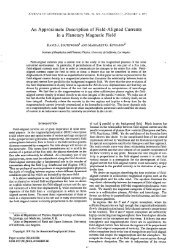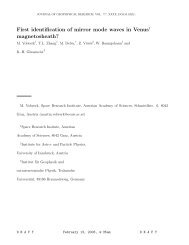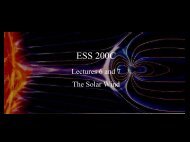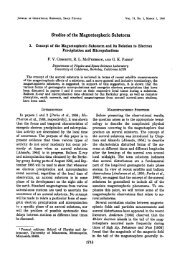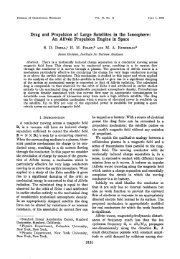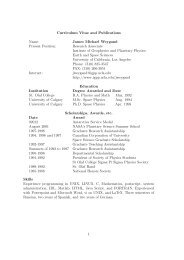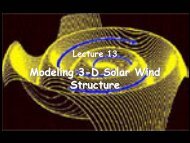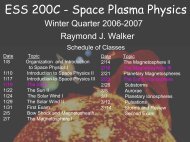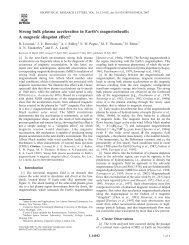Outer magnetospheric structure: Jupiter and Saturn compared
Outer magnetospheric structure: Jupiter and Saturn compared
Outer magnetospheric structure: Jupiter and Saturn compared
Create successful ePaper yourself
Turn your PDF publications into a flip-book with our unique Google optimized e-Paper software.
A04224<br />
WENT ET AL.: OUTER MAGNETOSPHERIC STRUCTURE<br />
A04224<br />
Figure 2. Ulysses observations in the Jovian magnetosphere. (a) Jovian System III magnetic field components<br />
(B R ,red;B , blue or white; B ,green)<strong>and</strong>±∣B∣ (black). (b) Normalized poloidal field components<br />
(∣B ∣/∣B∣, blue or white; ∣B R ∣/∣B∣, red). (c) Angle INT between the observed magnetic field, B OBS ,<strong>and</strong><br />
the internal magnetic field, B INT . Horizontal dashed lines denote the critical magnetodisk angles of 50°<br />
<strong>and</strong> 180 − 50 = 130°. (d) Thirty‐minute normalized magnetic field RMS fluctuation. (e) SWOOPS thermal<br />
electron density (blue or white) <strong>and</strong> temperature (red). Vertical dashed lines denote local minima in absolute<br />
magnetic latitude, ∣l M ∣,which beyond 50 R J corresponds to l M = 0°. The inner magnetosphere (blue), magnetodisk<br />
(yellow), transition region (white), cushion region (green), boundary layers (cyan), magnetopause<br />
crossings (red), <strong>and</strong> magnetosheath (grey) are shaded. The radial distance, planetocentric latitude, <strong>and</strong> local<br />
time of the spacecraft are shown along the x axis.<br />
due to the rocking motion of the rotating planetary dipole<br />
which is inclined by ≈10° to the rotation axis. Beyond the<br />
magnetodisk the field direction rotates slowly <strong>and</strong>, for R ><br />
83 R J , Ulysses explores a third <strong>magnetospheric</strong> region which<br />
is once again dipolar. This is the outer magnetosphere or<br />
cushion region, shaded green, separated from the magnetodisk<br />
by a roughly 14 R J transition region of intermediate<br />
properties, shaded white. In the transition region the disturbed<br />
magnetic field rotates through ∼90° <strong>and</strong> the two poloidal field<br />
components are comparable in magnitude.<br />
[10] The cushion region electron density (measured by<br />
the SWOOPS instrument [Bame et al., 1992]) is ∼10 −2 cm −3<br />
while, in contrast, the first crossing of the magnetodisk<br />
plasma sheet in the middle magnetosphere is associated with<br />
an electron density almost an order of magnitude higher.<br />
At the radial distance of this crossing (≈68 R J ) the electron<br />
density observed in the magnetodisk lobes is comparable to<br />
that seen previously in the overlaying cushion region. Both<br />
the plasma sheet <strong>and</strong> magnetodisk lobe density decrease upon<br />
approaching the planet, a counterintuitive observation interpreted<br />
by Phillips et al. [1993] as an effect associated with<br />
Ulysses unusual trajectory. In order to launch Ulysses into<br />
a polar orbit around the sun, the planetocentric latitude of<br />
the spacecraft increased significantly on approaching <strong>Jupiter</strong>.<br />
This is clearly evident from the top right panel of Figure 3<br />
where the meridional projection of Ulysses’s <strong>Jupiter</strong> flyby<br />
trajectory is shown in red. The high planetocentric latitude<br />
also explains the B R dominated field seen in the quasi‐dipolar<br />
( < 50°) inner magnetosphere. As can be seen from Figure 2e,<br />
where density is plotted in blue/white <strong>and</strong> temperature in red, a<br />
transient density (temperature) increase (decrease) is observed<br />
at roughly 24 R J . This feature is interpreted by Phillips et al.<br />
[1993] as a spacecraft traversal of high‐latitude open field<br />
lines.<br />
[11] The highly disturbed nature of the transition region<br />
field is clear when the RMS fluctuation (calculated from the<br />
3of14



